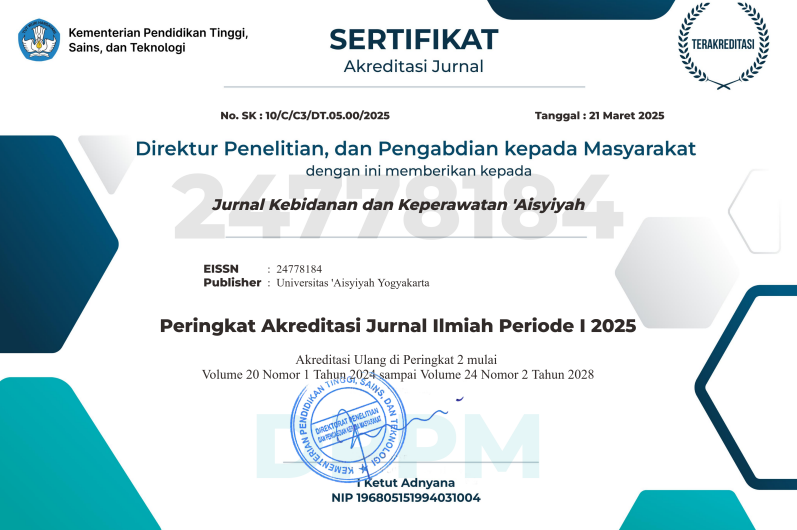Cyberbullying sebagai faktor risiko perilaku kekerasan pada pasien Remaja di RSJ Grhasia Yogyakarta
DOI:
https://doi.org/10.31101/jkk.2412Abstract views 1106 times
Keywords:
cyberbullying, perilaku kekerasan, remajaAbstract
Downloads
References
Alhajji, M., Bass, S., & Dai, T. (2019). Cyberbullying, Mental Health, and Violence in Adolescents and Associations With Sex and Race: Data From the 2015 Youth Risk Behavior Survey. Global Pediatric Health, 6. https://doi.org/10.1177/2333794X19868887
APJII. (2018). Laporan Survei Penetrasi & Profil Pengguna Internet di Indonesia. Polling Indonesia.
Astuti, Y. D., & Dewi, N. S. (2021). Peran Dan Intensitas Cyberbullying Pada Siswa SMP. Jurnal Ilmiah Kesehatan, 14(2), 123–130. https://doi.org/10.48144/jiks.v14i2.570
Bonanno, R. A., & Hymel, S. (2013). Cyber Bullying and Internalizing Difficulties: Above and Beyond the Impact of Traditional Forms of Bullying. Journal of Youth and Adolescence, 42(5), 685–697. https://doi.org/10.1007/s10964-013-9937-1
Buelga, S., Postigo, J., MartÃnez-Ferrer, B., Cava, M. J., & Ortega-Barón, J. (2020). Cyberbullying among adolescents: Psychometric properties of the CYB-AGS cyber-aggressor scale. International Journal of Environmental Research and Public Health, 17(9). https://doi.org/10.3390/ijerph17093090
Chang, F., Lee, C., Chui, C., Hsi, W., Huang, T., & Pan, Y. (2013). Relationships Among Cyberbullying, School Bullying , and Mental Health in Taiwanese. Journal of School Health, 83(6), 454–462.
Cho, M.-K., Kim, M., & Shin, G. (2017). Effects of Cyberbullying Experience and Cyberbullying Tendency on School Violence in Early Adolescence. The Open Nursing Journal, 11(1), 98–107. https://doi.org/10.2174/1874434601711010098
Co-ordinated Action Against Domestic Abuse (CAADA). (2014). In plain sight: the evidence from children exposed to domestic abuse. CAADA Research Report, 2(Insights into domestic abuse). https://www.scie-socialcareonline.org.uk/in-plain-sight-the-evidence-from-children-exposed-to-domestic-abuse-caada-research-report/r/a11G0000003DZVEIA4
Darmayanti, K. K. H., Kurniawati, F., & Situmorang, D. D. B. (2019). Bullying di Sekolah: Pengertian, Dampak, Pembagian dan Cara Menanggulanginya. Pedagogia Jurnal Ilmu Pendidikan, 17(1), 55–66.
Debnam, K. J., Johnson, S. L., & Bradshaw, C. P. (2014). Examining the Association Between Bullying and Adolescent Concerns About Teen Dating Violence. Journal of School Health, 84(7), 421–428. https://doi.org/10.1111/josh.12170
Dewi, H. A., Suryani, & Sriati, A. (2020). Faktor-Faktor yang Memengaruhi Cyberbullying Pada Remaja: A Systematic Review. Journal of Nursing Care, 3(2), 128–141. http://jurnal.unpad.ac.id/jnc/article/view/24477
Ellington, E. (2016). Psychiatric nursing’s role in child abuse. Psychosocial Nursing and Mental Health Servicies, 55(11), 16–21.
Garaigordobil, M., & Machimbarrena, J. M. (2017). Estrés, competencia y prácticas educativas parentales en vÃctimas y agresores de bullying y cyberbullying. Psicothema, 29(3), 335–340. https://doi.org/10.7334/psicothema2016.258
Gómez-Ortiz, O., Romera, E. M., Ortega-Ruiz, R., & Del Rey, R. (2018). Parenting practices as risk or preventive factors for adolescent involvement in cyberbullying: Contribution of children and parent gender. International Journal of Environmental Research and Public Health, 15(12). https://doi.org/10.3390/ijerph15122664
Hana, D. R., & Suwarti, S. (2020). Dampak Psikologis Peserta Didik yang Menjadi Korban Cyber Bullying. Psisula: Prosiding Berkala Psikologi, 1(11), 20–28. https://doi.org/10.30659/psisula.v1i0.7685
Hinduja, S., & Patchin, J. W. (2015). Cyberbullying and Online Aggression Survey Instrument. Bullying Beyond the Schoolyard: Preventing and Responding to Cyberbullying, 42(5), 711–722.
Kowalski, R. M., Giumetti, G. W., Schroeder, A. N., & Lattanner, M. R. (2014). Bullying in the digital age: A critical review and meta-analysis of cyberbullying research among youth. Psychological Bulletin, 140(4), 1073–1137. https://doi.org/10.1037/a0035618
Livazović, G., & Ham, E. (2019). Cyberbullying and emotional distress in adolescents: the importance of family, peers and school. Heliyon, 5(6). https://doi.org/10.1016/j.heliyon.2019.e01992
Malihah, Z., & Alfiasari. (2018). Cyberbullying among Teenager and Its Relationship with Self-Control and Parents- Child Communication. Jurnal Ilmu Keluarga Dan Konsumen, 11(2), 145–156.
Meinarni, N. P. S. (2019). Tinjauan Yuridis Cyber Bullying Dalam Ranah Hukum Indonesia. Ganaya : Jurnal Ilmu Sosial Dan Humaniora, 2(1), 299–308. https://www.bps.go.id/dynamictable/2018/05/18/1337/persentase-panjang-jalan-tol-yang-beroperasi-menurut-operatornya-2014.html
Natalia, E. (2016). Remaja, Media Sosial dan Cyberbullying. Jurnal Ilmiah Komunikasi, 5, 119–137.
Nazriani, D., & Zahreni, S. (2017). Adolescent Cyberbullying in Indonesia : Differentiation between Bullies and Victim. 81(Icosop 2016), 505–508. https://doi.org/10.2991/icosop-16.2017.68
PPNI. (2016). Standar Diagnosis Keperawatan Indonesia (1st ed.). DPP PPNI.
Pramono, H., Sadarwati, S., & Rohmadi, H. (2021). Gambaran Diagnosis Keperawatan Di IGD RSJ Grhasia Yogyakarta. Jurnal Ilmiah Kesehatan, 14(2), 110–115. https://doi.org/10.48144/jiks.v14i2.580
Primasti, D., & Dewi, S. I. (2017). Pengaruh Media Sosial Terhadap Penyimpangan Perilaku Remaja (Cyberbullying). Jurnal Reformasi, 7(2), 34–43.
Rose, C. A., & Tynes, B. M. (2015). Longitudinal Associations between Cybervictimization and Mental Health among U.S. Adolescents. Journal of Adolescent Health, 57(3), 305–312. https://doi.org/10.1016/j.jadohealth.2015.05.002
RSJ Grhasia. (2021). Sistem Informasi dan Manajemen Keperawatan.
Safaria, T. (2016). Prevalence and impact of cyberbullying in a sample of indonesian junior high school students. Turkish Online Journal of Educational Technology, 15(1), 82–91.
Sharma, D., Kishore, J., Sharma, N., & Duggal, M. (2017). Aggression in schools: Cyberbullying and gender issues. Asian Journal of Psychiatry, 29, 142–145. https://doi.org/10.1016/j.ajp.2017.05.018
Soeli, Y. M., Djunaid, R., Rizky, A., & Rahman, D. (2019). Analisis Faktor yang Berhubungan Dengan Kejadian Perilaku Kekerasan Pada Remaja. Jambura Nursing Journal, 1(2), 85–95. https://doi.org/10.37311/jnj.v1i2.2511
Stuart, G. W. (2016). Prinsip dan Praktik Keperawatan Kesehatan Jiwa Stuart (B. A. Kelliat & J. Pasaribu (eds.); 1st Indone). Elsevier.
Syena, I., Hernawaty, T., & Setyawati, A. (2019). Gambaran Cyberbullying Pada Siswa di SMA X Kota Bandung. Ejurnal.Univbsi.Id, 7(Vol 7 No 2 (2019): Jurnal Keperawatan BSI), 88–96.
Tjongjono, B., Gunardi, H., Pardede, S. O., & Wiguna, T. (2019). Perundungan-siber (Cyberbullying) serta Masalah Emosi dan Perilaku pada Pelajar Usia 12-15 Tahun di Jakarta Pusat. Sari Pediatri, 20(6), 342. https://doi.org/10.14238/sp20.6.2019.342-8
Topcua, Ç., & Erdur-Bakerb, Ö. (2018). RCBI-II: The second revision of the Revised Cyber Bullying Inventory. Measurement and Evaluation in Counseling and Development, 51(1), 32–41. https://doi.org/10.1080/07481756.2017.1395705
UNESCO. (2019). Behind the numbers: Ending school violence and bullying. Sustainable Development Goals: Education 2030, 1–74.
UNICEF & Kominfo. (2015). “Digital Citizenship Safety among Children and Adolescents in Indonesia†(Keamanan Penggunaan Media Digital pada Anak dan Remaja di Indonesia). Kementerian Komunikasi dan Informasi.
Vagi, K. J., Olsen, E. O. M., Basile, K. C., & Vivolo-Kantor, A. M. (2015). Teen dating violence (physical and sexual) among US high school students: Findings from the 2013 National Youth Risk Behavior Survey. JAMA Pediatrics, 169(5), 474–482. https://doi.org/10.1001/jamapediatrics.2014.3577
Van Geel, M., Vedder, P., & Tanilon, J. (2014). Relationship between peer victimization, cyberbullying, and suicide in children and adolescents ameta-analysis. JAMA Pediatrics, 168(5), 435–442. https://doi.org/10.1001/jamapediatrics.2013.4143
Videbeck, S. L. (2018). Buku Ajar Keperawatan Jiwa. EGC.
WHO. (n.d.). Definition and typology of violence. Retrieved September 10, 2020, from https://www.who.int/violenceprevention/approach/definition/en/
Yosep, I. (2014). Keperawatan Jiwa. PT Refika Aditama.
Yuliati, R., & Saptyasari, A. (2019). Cyberbullying Involvement: Impacts of Violence Exposure in The Media, Family, Society, and School. Jurnal Komunikasi Indonesia, 3(1), 5–11. https://doi.org/10.7454/jki.v3i1.9857
Zahrawaani, M., & Nurhaeni, N. (2020). Faktor Risiko Remaja Menjadi Pelaku Kekerasan: A Literature Review. Jurnal Penelitian Kesehatan “SUARA FORIKES†(Journal of Health Research “Forikes Voiceâ€), 11(April), 21. https://doi.org/10.33846/sf11nk203
Zsila, Ã., Orosz, G., Király, O., Urbán, R., Ujhelyi, A., Jármi, É., Griffiths, M. D., Elekes, Z., & Demetrovics, Z. (2018). Psychoactive Substance Use and Problematic Internet Use as Predictors of Bullying and Cyberbullying Victimization. International Journal of Mental Health and Addiction, 16(2), 466–479. https://doi.org/10.1007/s11469-017-9809-0
Downloads
Additional Files
Published
How to Cite
Issue
Section
License
With the receipt of the article by the Jurnal Kebidanan dan Keperawatan Aisyiyah Editorial Board and the decision to be published, then the copyright regarding the article will be diverted to Jurnal Kebidanan dan Keperawatan Aisyiyah. Universitas 'Aisyiyah Yogyakarta as the publisher of Jurnal Kebidanan dan Keperawatan Aisyiyah hold the copyright regarding all the published articles in this journal.
Jurnal Kebidanan dan Keperawatan Aisyiyah is licensed under a Creative Commons Attribution-ShareAlike 4.0 International License.
















